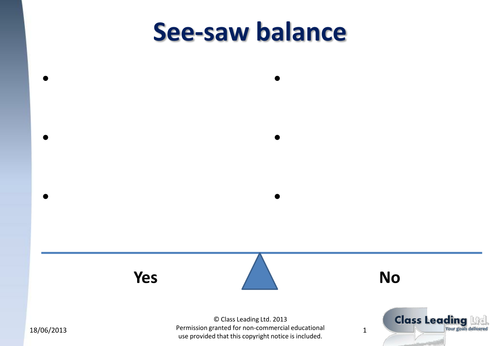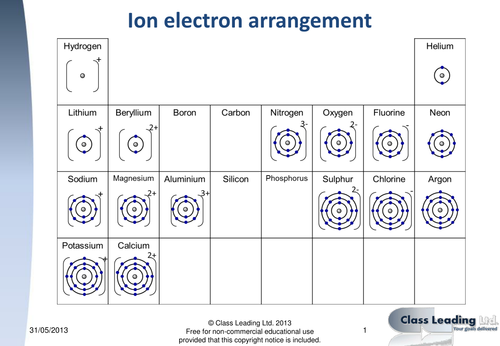314Uploads
262k+Views
194k+Downloads
All resources

Weighing up arguments - See saw writing frame
This resource is a collection of 6 slightly different see-saw balances that can be used with learners to help them develop the skills to weigh up an argument. The idea is that students will list reasons on both side of an argument (e.g. Should we have Nuclear Power?). They then use this to help make a decision. The scoring column on some sheets allows learners to score each argument out of a maximum of say 3. Add the scores on each side to see which has the stronger argument. This also includes phrases to support a more detailed conclusion. This was inspired by 21st Century Science.

Car efficiency - Data handling
Keywords: Efficiency, calculation, graph, skill, explain, justify, MAT.
This activity is designed to stretch the most able learners with some questions and tasks related to calculating efficiency. There are some demanding questions involving handling data and using graphs to make predictions. This was designed as a home learning task to consolidate learning about efficiency.
It would also make a suitable starter for AS/A level.
An answer sheet is included with suggested marks for each question.

Jelly fossils - Modelling
In this activity, pupils go through the process of making a fossil of a jelly sweet to show how fossilisation takes place. A description of how to do this is included in the guide. Please ensure that you have carried out a full risk assessment before carrying out any practical activity.

Hydrocarbon molecules - graded questions
This activity contains a powerpoint with graded questions & answers and matching pupil activity sheets, designed to be used at the end of a lesson and/or the start of the next lesson to review previous learning. The questions are based on the previous OCR 21st Century Science Specification unit C2, although could be used with other exam boards.
Clicking through the show reveals answers one a time. These reduce to A5 easily, the ideal size for most pupils. Please note grades are approximate.

Male or female - graded questions
This activity contains a powerpoint with graded questions & answers and matching pupil activity sheets, designed to be used at the end of a lesson and/or the start of the next lesson to review previous learning. The questions are based on the previous OCR 21st Century Science Specification unit B1, although could be used with other exam boards.
Clicking through the show reveals answers one a time. These reduce to A5 easily, the ideal size for most pupils. Please note grades are approximate.

Natural vs synthetic polymers - graded questions
This activity contains a powerpoint with graded questions & answers and matching pupil activity sheets, designed to be used at the end of a lesson and/or the start of the next lesson to review previous learning. The questions are based on the previous OCR 21st Century Science Specification unit C2, although could be used with other exam boards.
Clicking through the show reveals answers one a time. These reduce to A5 easily, the ideal size for most pupils. Please note grades are approximate.

The Alkanes Summary (flipped learning)
This is a collection of separate pdf documents that help learners summarise information about the alkanes.
Each of the different sheets allows for a different level of support and challenge
- Sheet A is totally blank.
- Sheets B and C have fewer sections to fill in.
- Sheet D has all of the molecules drawn.
- Sheets E involves some reading for information and only has a limited amount of information and could be good for the least able.
- Sheet F, many of the answers can be deduced (at least approximately) and can be good for stretching the most able.
It is intended that the activity be carried out as 'flipped learning' so that learners complete this activity before learning about the alkanes and/or fractional distillation.

Reactivity of metals timeline (starter)
Keywords: metal, reactivity, extraction
A short activity (starter?) to encourage higher order thinking and identify relationship between reactivity of metals and their date of first extraction.
Please note that this was originally published a number of years ago as part of the North Yorkshire Success for All project of which I was part and had the pleasure of working with an excellent team of teachers on resource development.
Included is the original briefing sheet and a powerpoint slideshow

Evidence for climate change - data handling
This is a short standalone activity linked with the topic of climate change, global warming and icecap melting. It is intended to develop higher-order thinking skills and understanding of data. It aims to provide an opportunity for cognitive conflict and discussion.
There are two ways this task can be attempted:
Allow the students to work through the first two set of tasks sequentially. Hand out only the sheet with a triangle in the top right of the page. When this is completed, hand out only the sheet with the square. Finally, when this is completed give out the third and final sheet with questions 4 onwards.
Alternatively…
One half of class is given the first sheet, marked with a triangle. The other half is given the ones marked with a square. Pupils work on their own sheets independently. After a few minutes, pupils who have completed different sheets pair up. They compare their sheets and answer the questions on the third sheet together.
When this was tested, pupils responded well to the tricky questions.

The carbon cycle - grade questions
This activity contains a powerpoint with graded questions & answers and matching pupil activity sheets, designed to be used at the end of a lesson and/or the start of the next lesson to review previous learning. The questions are based on the previous OCR 21st Century Science Specification unit P2, although could be used with other exam boards.
Clicking through the show reveals answers one a time. These reduce to A5 easily, the ideal size for most pupils. Please note grades are approximate.

Electron arrangements for ions
Keywords: ionic, ions, electron, shell, energy level, orbitals, rings, periodic table.
This resource contains an animated powerpoint show and two sheets. These can be used as a revision tool or as an independent learning resource to help students explore and spot patterns in ion formation in the periodic table. Please note that there is a similar resource showing the electron arrangement for the first 20 elements
Right click the web links to download the powerpoint shows.

Average & Instantaneous speed - graded questions
This activity contains a powerpoint with graded questions & answers and matching pupil activity sheets, designed to be used at the end of a lesson and/or the start of the next lesson to review previous learning. The questions are based on the previous OCR 21st Century Science Specification unit P4, although could be used with other exam boards.
Clicking through the show reveals answers one a time. These reduce to A5 easily, the ideal size for most pupils. Please note grades are approximate.

Maths Skills - Units - Powers to Prefix Starter
These are a sequence of powerpoint shows designed as an instant engagement task (rolling on screen as learners enter the room for immediate engagement with learning). Learners write down the prefix that represents the power of ten multiplier. They are essentially the same task (with rearranged slides) but get progressively more demanding (as the changeover of slide gets faster) as the numbers in brackets increase. Start the students with (1) and then as they get faster, use the more demanding versions.

Active modelling - String vs mobile phone
Keywords: digital, analogue, encode, decode.
Notes: This activity helps learners compare how a simple string telephone works against a more complex digital system. Get the students to make string telephones using paper/plastic cups and lengths of string before attempting to complete the sheet. This helps explain an abstract idea by building up from a very hands on simple (more concrete) example. It really engages learners of all abilities. There is an activity sheet and a guidance sheet with answers. This was originally designed for OCR 21st Century Science unit P2

Tweet Sheets - Summarising learning
This resource consists of three sheets, each of which is made up of 6 squares that can be cut out and given to learners. They can be used by learners to summarise their learning. This is ideal for the review phase (plenary) of a lesson or before the lesson with a flipped learning (classroom) approach.
There is a plain sheet and also versions to support neater writing by learners using an idea from dyslexia expert Neil Mackay. The highlighed version s help learners form neater letters in a similar way that half-way lined paper does. A grey version is included for B/W photocopying.

Engaging 'hats' model of electric circuits
Keywords: circuit, model, current, charge, electron, hats
This is an engaging model for students to participate in modelling electric circuits. It is aimed at KS3, but has been used successfully with KS4 and KS5. It helps students build a coherent model to explain circuits, although alternative models help explain energy transfers and potential difference (voltage) better.
Please note that this was originally published a number of years ago as part of the North Yorkshire Success for All project.
A premium PowerPoint slideshow that provides a visual model of the motion of charges in the circuit is also available at https://www.tes.com/teaching-resource/resource-12613884

Life cycle analysis - graded questions
This activity contains a powerpoint with graded questions & answers and matching pupil activity sheets, designed to be used at the end of a lesson and/or the start of the next lesson to review previous learning. The questions are based on the previous OCR 21st Century Science Specification unit C2, although could be used with other exam boards.
Clicking through the show reveals answers one a time. These reduce to A5 easily, the ideal size for most pupils. Please note grades are approximate.

Ohm's Law - graded questions
This activity contains a powerpoint with graded questions & answers and matching pupil activity sheets, designed to be used at the end of a lesson and/or the start of the next lesson to review previous learning. The questions are based on the previous OCR 21st Century Science Specification unit P5, although could be used with other exam boards.
Clicking through the show reveals answers one a time. These reduce to A5 easily, the ideal size for most pupils. Please note grades are approximate.

Resistance - graded questions
This activity contains a powerpoint with graded questions & answers and matching pupil activity sheets, designed to be used at the end of a lesson and/or the start of the next lesson to review previous learning. The questions are based on the previous OCR 21st Century Science Specification unit P5, although could be used with other exam boards.
Clicking through the show reveals answers one a time. These reduce to A5 easily, the ideal size for most pupils. Please note grades are approximate.

Force & Change of momentum - graded questions
This activity contains a powerpoint with graded questions & answers and matching pupil activity sheets, designed to be used at the end of a lesson and/or the start of the next lesson to review previous learning. The questions are based on the previous OCR 21st Century Science Specification unit P4, although could be used with other exam boards.
Clicking through the show reveals answers one a time. These reduce to A5 easily, the ideal size for most pupils. Please note grades are approximate.




















